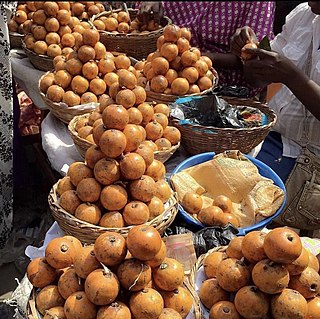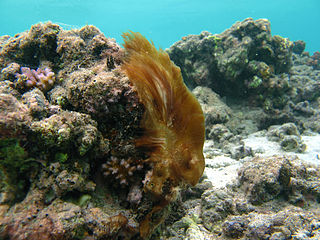
Black band disease is a coral disease in which corals develop a black band. It is characterized by complete tissue degradation due to a pathogenic microbial consortium. The mat is present between apparently healthy coral tissue and freshly exposed coral skeleton.

Lemon basil, hoary basil, Thai lemon basil, or Lao basil, is a hybrid between basil and American basil. The herb is grown primarily in northeastern Africa and southern Asia for its fragrant lemon scent, and is used in cooking.

Agriotherium is an extinct genus of bears whose fossils are found in Miocene through Pleistocene-aged strata of North America, Europe, Africa, and Asia. This long-lived genus persisted from at least ~11.6–2.5 Mya. Materials from the late-surviving A. africanum in Africa have suggested that A. africanum died out during the early Gelasian.

Poroderma is a genus of catsharks, and part of the family Scyliorhinidae. The color of these sharks are usually grey with dark stripes. They are found in South Africa and are nocturnal. They live preferably in shore areas, close to the bottom, to depths of 100 m. They prefer small caves and crevices. Their diet usually consists of crustaceans, but they also feed on small fish. Their average size is between 60 and 80 cm, with a maximum total length of about 100 cm. Their birth size is about 15 cm. They are harmless to humans.

The pyjama shark or striped catshark is a species of catshark, and part of the family Scyliorhinidae, endemic to the coastal waters of South Africa. This abundant, bottom-dwelling species can be found from the intertidal zone to a depth of around 100 m (330 ft), particularly over rocky reefs and kelp beds. With a series of thick, parallel, dark stripes running along its stout body, the pyjama shark has an unmistakable appearance. It is additionally characterized by a short head and snout with a pair of slender barbels that do not reach the mouth, and two dorsal fins that are placed far back on the body. It can grow up to a length of 1.1 m (3.6 ft) long.
Mycobacterium africanum is a species of Mycobacterium that is most commonly found in West African countries, where it is estimated to cause up to 40% of pulmonary tuberculosis. The symptoms of infection resemble those of M. tuberculosis.

Gnetum africanum is a vine gymnosperm species found natively throughout tropical Africa. Though bearing leaves, the genus Gnetum are gymnosperms, related to pine and other conifers.
Eogavialis is an extinct genus of eusuchian crocodylomorph, usually regarded as a gavialoid crocodylian. It superficially resembles Tomistoma schlegelii, the extant false gharial, and consequently material from the genus was originally referred to Tomistoma. Indeed, it was not until 1982 that the name Eogavialis was constructed after it was realised that the specimens were from a more basal form.

Corymbium is a genus of flowering plants in the daisy family comprising nine species. It is the only genus in the subfamily Corymbioideae and the tribe Corymbieae. The species have leaves with parallel veins, strongly reminiscent of monocots, in a rosette and compounded inflorescences may be compact or loosely composed racemes, panicles or corymbs. Remarkable for species in the daisy family, each flower head contains just one, bisexual, mauve, pink or white disc floret within a sheath consisting of just two large involucral bracts. The species are all endemic to the Cape Floristic Region of South Africa, where they are known as plampers.
P. africanum may refer to:

Cyclamen africanum is a species of flowering plant in the family Primulaceae. It is referred to by the common name African cyclamen and is a perennial growing from a tuber, native to northern Algeria, Morocco and Tunisia. It is similar to Cyclamen hederifolium, but not frost-hardy.
Erythrophleum africanum, the African blackwood, is a legume species in the genus Erythrophleum found in Savannahs of tropical Africa. It produces a gum similar to gum arabic.

Chrysophyllum africanum is a forest fruit tree commonly found throughout tropical Africa.

The Weeping wattle is a semi-deciduous to deciduous flowering tree growing to about 15 meters tall. It is native to Africa south of the equator. Their yellow flowers bloom on the ends of branches in upright, showy sprays.
Nasturtium africanum, the Moroccan watercress, is an aquatic plant endemic to Morocco. Two subspecies are recognized:

Phormidium is a genus of cyanobacteria in the family Oscillatoriaceae.
Phormidium aerugineo-caeruleum is a species of cyanobacteria in the genus Phormidium.
Phormidium allorgei is a species of cyanobacteria in the genus Phormidium.
Phormidium ambiguum is a species of cyanobacteria in the genus Phormidium.









